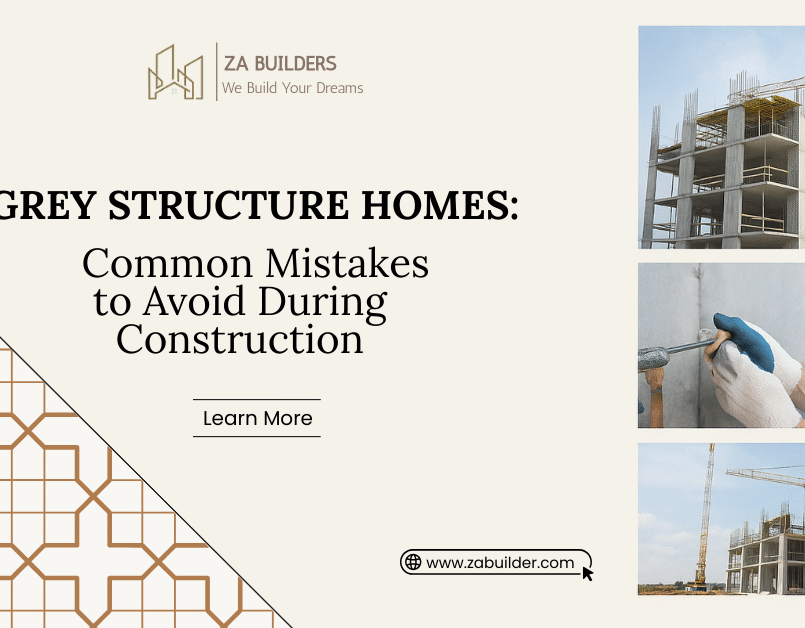Tips for Successful Grey Structure Construction Planning
Did you realize that around 70% of a building’s support relies solely on the grey structure phase?
You can safely say that the foundation, framework and skeleton of the structure give a building its strength and endurance for years to come. As Pakistan’s real estate and construction industry grows fast, companies such as ZA Builders are revolutionizing grey structure construction through the use of new and established practices.
If you have building, investment or homeownership plans, learning the process of this stage can help you avoid making costly errors and facing delays or future issues. Here are some tried-and-true techniques to help you achieve success with your grey structure design.
What does the term Grey Structure Construction refer to?
To begin, we should describe what the grey structure actually involves. Simply put, the grey structure is comprised of:
The process involves digging out the land and creating the foundation.
- The business is built on an established structure.
- Columns, beams and slabs
- Brickwork and walls.
- Roofing
- Coarse plastering
- Basic planning for plumbing and electrical piping
- Staircases
During this stage, you won’t need paint, tiles, doors, windows or finishes — they come later, during the last phase.
Choose the Right Grey Construction Group
Your builder can make or break the entire project. Reputable companies like ZA Builders are known for their attention to detail, quality control, and adherence to deadlines. When selecting a grey construction group, look for:
- Proven track record in grey structure projects
- Licensed engineers and certified architects
- Clear communication channels
- Transparent pricing
- Use of quality materials
Pro tip: Always ask for a project portfolio and client references before signing any contracts.
Detailed Site Survey and Soil Testing
The foundation of your structure depends heavily on the type of soil present. Before beginning grey structure construction, conduct a detailed site survey and soil analysis. Soil testing helps determine:
- Load-bearing capacity
- Water retention levels
- Required depth for foundation
- Risk of shifting or sinking
Ignoring this step can lead to structural instability down the road — something even the best design can’t fix.
Plan the Layout with Structural Engineers
Collaboration between your architect and structural engineer during the planning stage is essential. Your layout should not just be aesthetically pleasing but structurally sound. Engineers will assess:
- Load distribution across beams and columns
- Proper reinforcement placement
- Earthquake resistance (especially in seismic zones)
The right design ensures that your grey structure doesn’t just stand — it withstands.
Stick to Approved Drawings and Legal Permissions
Start only after all designs are approved and NOCs (No Objection Certificates) are obtained. Unauthorized changes can cause:
- Legal complications
- Increased construction costs
- Safety hazards
Work closely with your grey construction group to ensure every step complies with municipal codes and safety standards.
Budget Planning and Cost Transparency
While grey structure costs are significantly lower than the finishing phase, they still form a large chunk of the total project budget. Be realistic about your budget and include costs for:
- Cement, bricks, steel
- Excavation and labor
- Drainage and plumbing rough-ins
- Electrical conduit placement
- Site security and temporary facilities
At ZA Builders, clients are provided with detailed BOQs (Bill of Quantities) upfront to avoid mid-project financial shocks.
Source High-Quality Materials
Cutting costs by compromising on materials during grey structure construction is a false economy. Use only standard-approved:
- Cement (OPC or SRC depending on soil)
- Bricks (A-class, well-burnt)
- Steel (properly graded)
- Clean and graded sand and gravel.
You should leave the procurement to your grey construction group since the established builders can get vetted suppliers and can maintain uniform quality.
Plan Ahead and Monitor the Progress
The construction of a grey structure normally takes 3-6 months depending on the size and design of the building. A timeline is necessary but one has to be flexible with it. Here’s what to do:
- Develop a dynamic but planned building program.
- Divide the project into weekly milestones.
- Meetings on the site regularly to review the progress.
- Modify schedules in response to weather and delivery delays.
An example of this is ZA Builders where they have adopted project tracking software and assigned special project managers to oversee each stage of the project to ensure it runs smoothly.
Make Onsite Safety and Supervision a priority
The work of grey structure includes bulky materials, machines, and a lot of labor. Safety on the site should be a must.
- Provide employee protection equipment.
- Install correct scaffold and signage.
- Check on risk (falling material, unsafe wiring, etc.)
- Enforce high labor standards.
Frequent inspection not only ensures the safety of employees, but also the quality of the work being produced. Any discrepancy or dislocation during this stage may prove to be quite expensive to rectify in the future.
Weather and Site Management
Construction may be inhibited by seasonal changes, such as monsoon or extreme heat. Excavation and concrete work of plans in dry seasons where feasible. Also do the following:
- Waterproof storage provision areas.
- Provide adequate drainage of the site.
- Cure concrete slabs in a proper way that will avoid cracks.
The idea of running your site like a well-oiled machine is an important factor in the construction of a grey structure.
Documentation, Photos, and Quality Checks
As you build, document everything:
- Capture photos at every phase
- Maintain daily construction logs
- Store invoices and delivery slips.
- Get third-party inspection (where necessary)
This openness develops trust in your construction team and it also gives you peace of mind that your money was heading in the right direction.
Closure: Build Strong, Build Smart
The backbone of your future home, office and commercial project is a well planned grey structure. When properly executed, it provides the groundwork (literally and figuratively) towards a successful, long-lasting, and safe construction. Site testing, supervision and safety, all details count.
Working with an established grey construction company such as ZA Builders guarantees your venture will be undertaken by individuals who are concerned about quality, integrity and timeframes.
Grey may be the color – but the results are black and white: Build strong or Build again.
Want to start your construction business on the right foot? Allow ZA Builders to take your grey structure project to blueprint and reality.
Frequently Asked Questions
The time of a home renovation will depend on the scope of the project. As an example, a complete house remodel can require 6-12 months, whereas a kitchen remodel can require about 6 weeks.
Adding easy outdoor living space, remodeling kitchen and bathroom, and adding energy efficiency are the best additions that offer the best ROI.
Yes, there are reputable contractors who usually provide warranties in their projects. The particulars of the warranty, its duration, and limits are determined by the scope of the project.



